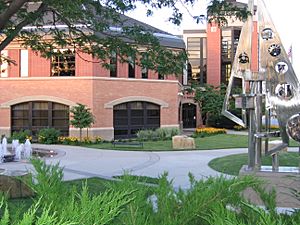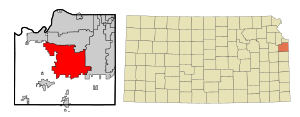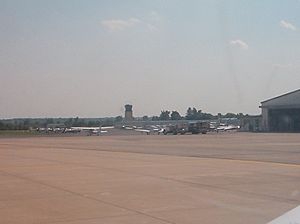Olathe, Kansas facts for kids
Quick facts for kids
Olathe, Kansas
|
||
|---|---|---|
|
City and County seat
|
||

Olathe City Hall (2010)
|
||
|
||

Location within Johnson County and Kansas
|
||
| Country | United States | |
| State | Kansas | |
| County | Johnson | |
| Founded | 1857 | |
| Incorporated | 1857, 1868 | |
| Government | ||
| • Type | Mayor–council | |
| Area | ||
| • Total | 62.39 sq mi (161.57 km2) | |
| • Land | 61.63 sq mi (159.62 km2) | |
| • Water | 0.76 sq mi (1.96 km2) 1.26% | |
| Elevation | 1,037 ft (316 m) | |
| Population
(2020)
|
||
| • Total | 141,290 | |
| • Estimate
(2021)
|
143,014 | |
| • Density | 2,264.63/sq mi (874.48/km2) | |
| Time zone | UTC-6 (CST) | |
| • Summer (DST) | UTC-5 (CDT) | |
| ZIP codes |
66051,66061,66062,66063
|
|
| Area code | 913 | |
| FIPS code | 20-52575 | |
| GNIS ID | 485633 | |
Olathe (say "oh-LAY-thuh") is a city in Kansas, United States. It is the main city of Johnson County. Olathe is the fourth-largest city in the Kansas City metropolitan area and in the state of Kansas. In 2020, about 141,290 people lived there.
Contents
History of Olathe
How Olathe Started
Olathe was started by John T. Barton in the spring of 1857. He rode to the middle of Johnson County and picked out land for the town. He said the area was covered with beautiful wild flowers. He wanted to name the town "Beautiful."
Barton asked a Shawnee person how to say "Beautiful" in their language. The answer was "Olathe." The city was officially formed in 1857. It grew quickly and became the main city of Johnson County in 1859. This means it was where the county government was located.
Olathe During the Civil War
Before the Civil War, there were many fights in Kansas. These fights were between settlers who wanted to stop slavery and those from nearby Missouri who supported it. This time was called Bleeding Kansas.
Kansas became a free state in 1861, meaning slavery was not allowed. Even so, Olathe was not peaceful. In 1861, a military post was set up in the city to protect it.
On September 6, 1862, a surprise attack happened. William Quantrill, a leader of a group of Confederate fighters, raided the city. Many buildings were destroyed, and some people died. The military post was captured, but the oath the soldiers were forced to take was later canceled.
Confederate forces tried to raid Olathe two more times. Once in 1863, when Quantrill was on his way to Lawrence, Kansas. And again in 1864, when Sterling Price and his 10,000 soldiers passed through. After the Civil War ended in 1865, the military post in Olathe was closed.
Trails and Growth
Olathe was an important stop for travelers on the Oregon Trail, the California Trail, and the Santa Fe Trail. Local stores and businesses made money by helping these travelers.
The Mahaffie House was a popular place for wagons to get supplies. Today, it is a historical site run by the City of Olathe. People who work there wear old-fashioned clothes. You can ride in a stagecoach and see farm animals. It's a fun place for children to visit. They also have Civil War re-enactments and Wild West Days.
After the transcontinental railroad was built, the old trails became less important. Olathe became a small, quiet town for a while.
Modern Olathe
In the 1950s, the new interstate highway system, especially Interstate 35, connected Olathe to Kansas City, Missouri. This led to a huge increase in homes as Olathe became part of the Kansas City area.
In the 1980s, Olathe also saw a lot of business growth, which brought even more people. By 2001, Olathe's population was over 100,000. The city continues to grow, expanding into the farm areas around it.
Geography
Olathe is surrounded by other cities. Lenexa is to the north, Overland Park to the east, De Soto to the northwest, and Gardner to the southwest.
The city covers about 60.42 square miles (156.5 km2). Most of this is land, with 0.76 square miles (1.96 km2) being water. Olathe has two public lakes: Lake Olathe (172 acres) and Cedar Lake (45 acres).
Olathe's Black Bob Park is named after Hathawekela Shawnee Chief Black Bob.
Climate
Olathe has a climate with cold winters and hot summers. This is called a humid continental climate. In January, the average high temperature is about 39°F (4°C), and the low is 20°F (-7°C). In July, the average high is nearly 90°F (32°C).
The temperature reaches 90°F (32°C) about 36 days a year. It rarely drops below 10°F (-12°C). The first frost usually happens in late October or early November. The last frost is usually in late March or early April.
Olathe gets about 40 inches (1016 mm) of rain each year. Most of the rain falls in May and June. It snows about 19 inches (48 cm) on average during winter. Snowfall happens about 9 days a year.
| Climate data for Olathe, Kansas (1991–2020 normals, extremes 1893–2009) | |||||||||||||
|---|---|---|---|---|---|---|---|---|---|---|---|---|---|
| Month | Jan | Feb | Mar | Apr | May | Jun | Jul | Aug | Sep | Oct | Nov | Dec | Year |
| Record high °F (°C) | 74 (23) |
81 (27) |
92 (33) |
96 (36) |
101 (38) |
107 (42) |
114 (46) |
111 (44) |
107 (42) |
98 (37) |
85 (29) |
76 (24) |
114 (46) |
| Mean daily maximum °F (°C) | 38.7 (3.7) |
44.3 (6.8) |
54.9 (12.7) |
65.1 (18.4) |
74.5 (23.6) |
83.6 (28.7) |
88.2 (31.2) |
86.8 (30.4) |
79.1 (26.2) |
67.7 (19.8) |
54.3 (12.4) |
42.5 (5.8) |
65.0 (18.3) |
| Daily mean °F (°C) | 29.3 (−1.5) |
34.1 (1.2) |
44.3 (6.8) |
54.5 (12.5) |
65.0 (18.3) |
74.3 (23.5) |
78.8 (26.0) |
76.9 (24.9) |
68.8 (20.4) |
57.2 (14.0) |
44.5 (6.9) |
33.5 (0.8) |
55.1 (12.8) |
| Mean daily minimum °F (°C) | 20.0 (−6.7) |
23.9 (−4.5) |
33.7 (0.9) |
43.9 (6.6) |
55.5 (13.1) |
64.9 (18.3) |
69.4 (20.8) |
66.9 (19.4) |
58.4 (14.7) |
46.7 (8.2) |
34.6 (1.4) |
24.6 (−4.1) |
45.2 (7.3) |
| Record low °F (°C) | −26 (−32) |
−29 (−34) |
−8 (−22) |
8 (−13) |
22 (−6) |
39 (4) |
45 (7) |
41 (5) |
29 (−2) |
15 (−9) |
−2 (−19) |
−22 (−30) |
−29 (−34) |
| Average precipitation inches (mm) | 1.28 (33) |
1.73 (44) |
2.48 (63) |
4.12 (105) |
5.26 (134) |
5.23 (133) |
4.75 (121) |
4.46 (113) |
4.25 (108) |
3.05 (77) |
2.37 (60) |
1.75 (44) |
40.73 (1,035) |
| Average snowfall inches (cm) | 3.9 (9.9) |
3.3 (8.4) |
1.4 (3.6) |
0.3 (0.76) |
0.0 (0.0) |
0.0 (0.0) |
0.0 (0.0) |
0.0 (0.0) |
0.0 (0.0) |
0.3 (0.76) |
1.2 (3.0) |
3.4 (8.6) |
13.8 (35) |
| Average precipitation days (≥ 0.01 in) | 6.4 | 5.8 | 8.1 | 10.2 | 11.8 | 9.7 | 8.6 | 7.5 | 8.0 | 7.9 | 6.7 | 6.4 | 97.1 |
| Average snowy days (≥ 0.1 in) | 3.6 | 2.1 | 1.0 | 0.2 | 0.0 | 0.0 | 0.0 | 0.0 | 0.0 | 0.1 | 0.7 | 2.6 | 10.3 |
| Source: NOAA | |||||||||||||
People in Olathe (Demographics)
| Historical population | |||
|---|---|---|---|
| Census | Pop. | %± | |
| 1870 | 1,817 | — | |
| 1880 | 2,285 | 25.8% | |
| 1890 | 3,294 | 44.2% | |
| 1900 | 3,451 | 4.8% | |
| 1910 | 3,272 | −5.2% | |
| 1920 | 3,268 | −0.1% | |
| 1930 | 3,656 | 11.9% | |
| 1940 | 3,979 | 8.8% | |
| 1950 | 5,593 | 40.6% | |
| 1960 | 10,987 | 96.4% | |
| 1970 | 17,921 | 63.1% | |
| 1980 | 37,258 | 107.9% | |
| 1990 | 63,440 | 70.3% | |
| 2000 | 92,962 | 46.5% | |
| 2010 | 125,872 | 35.4% | |
| 2020 | 141,290 | 12.2% | |
| 2021 (est.) | 143,014 | 13.6% | |
| U.S. Decennial Census 2010-2020 |
|||
2020 Census Information
| Race / Ethnicity (NH = Non-Hispanic) | Pop 2000 | Pop 2010 | Pop 2020 | % 2000 | % 2010 | % 2020 |
|---|---|---|---|---|---|---|
| White alone (NH) | 80,157 | 97,840 | 100,691 | 86.23% | 77.73% | 71.27% |
| Black or African American alone (NH) | 3,390 | 6,474 | 8,262 | 3.65% | 5.14% | 5.85% |
| Native American or Alaska Native alone (NH) | 348 | 436 | 414 | 0.37% | 0.35% | 0.29% |
| Asian alone (NH) | 2,524 | 5,100 | 6,293 | 2.72% | 4.05% | 4.45% |
| Pacific Islander alone (NH) | 39 | 77 | 115 | 0.04% | 0.06% | 0.08% |
| Other race alone (NH) | 157 | 240 | 620 | 0.17% | 0.19% | 0.44% |
| Mixed race or Multiracial (NH) | 1,287 | 2,911 | 7,410 | 1.38% | 2.31% | 5.24% |
| Hispanic or Latino (any race) | 5,060 | 12,794 | 17,485 | 5.44% | 10.16% | 12.38% |
| Total | 92,962 | 125,872 | 141,290 | 100.00% | 100.00% | 100.00% |
The 2020 United States census counted 141,290 people in Olathe. There were 50,070 households and 37,409 families. About 27.7% of the people were under 18 years old. The average age was 36.3 years.
The average household income was about $96,548. The average family income was about $105,927. About 5.5% of the people lived below the poverty line. This included 6.6% of those under 18.
Economy
Olathe has many businesses and industrial parks. Some big companies here include Honeywell, Husqvarna, ALDI, Garmin, Grundfos, and Farmers Insurance Group. Farmers Insurance has more employees in Olathe than in any other city in the U.S.
The Federal Aviation Administration (FAA) has an air traffic control center in Olathe. This center helps manage air traffic in the sky. Johnson County also has an airport in Olathe called Johnson County Executive Airport. It is the second busiest airport in Kansas.
Largest Employers
Here are the largest employers in Olathe, based on a 2022 report:
| Number | Employer | Employees |
|---|---|---|
| 1 | GARMIN International | 4,600 |
| 2 | Olathe Unified School District | 4,500 |
| 3 | Olathe Health System | 2,500 |
| 4 | Johnson County Government | 2,400 |
| 5 | Farmers Insurance | 1,733 |
| 6 | City of Olathe | 962 |
| 7 | TransAm Trucking | 800 |
| 8 | TVH | 670 |
| 9 | FAA/Air Route Traffic Control Systems | 600 |
| 10 | Honeywell Aerospace Electronics Systems | 561 |
Education
Several school districts serve the city of Olathe. The main one is the Olathe USD 233 school district.
As of 2008, this district had about 26,894 students. It has 36 elementary schools, 10 middle schools, and five high schools. The high schools are Olathe North, Olathe South, Olathe East, Olathe Northwest, and Olathe West.
Olathe is also home to MidAmerica Nazarene University. It also has the Kansas School for the Deaf, which was started in 1861.
Infrastructure
Airports
Olathe has two airports:
- Johnson County Executive Airport
- New Century AirCenter
The closest airport with passenger flights is Kansas City International Airport in Platte County, Missouri.
Transportation
- Johnson County Transit runs a bus system throughout the county, including Olathe.
- The main train line for BNSF Railway, which goes from Chicago to Los Angeles, passes through Olathe.
Notable People
- Willie Aames is an actor and director. He was known for his roles in TV shows like Eight Is Enough and Charles in Charge.
- John Anderson, Jr. was the 36th governor of Kansas. He was born near Olathe.
- Earl Browder was a leader in the American Communist movement. He ran for president in 1936 and 1940.
- Jonathan Quinn was a football coach. He played for the NFL's Kansas City Chiefs and Chicago Bears.
- Darren Sproles is a former running back in the NFL. He played for the Chargers, Saints, and Eagles. He won Super Bowl LII with the Philadelphia Eagles.
- Buddy Rogers was an actor and jazz musician. He starred in Wings, which won the first Best Picture Oscar.
- Charles Miller was a saxophonist and flutist for the band War. He was a lead singer on the song "Low Rider."
See also
 In Spanish: Olathe (Kansas) para niños
In Spanish: Olathe (Kansas) para niños



